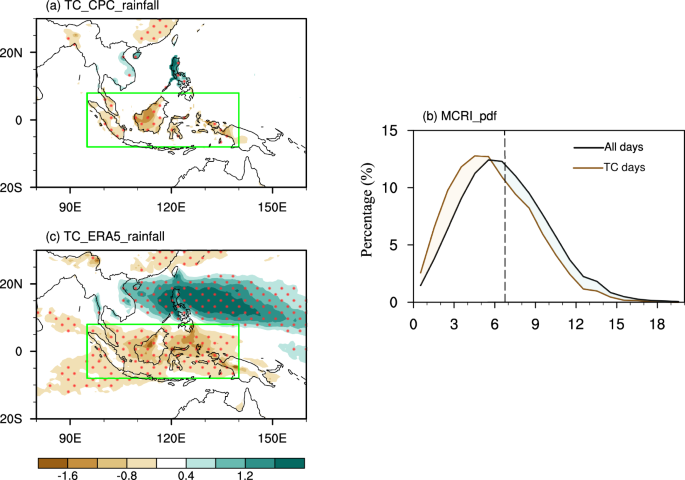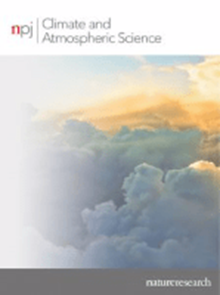北太平洋西部热带气旋抑制了海洋大陆的降雨量
IF 8.4
1区 地球科学
Q1 METEOROLOGY & ATMOSPHERIC SCIENCES
引用次数: 0
摘要
一般认为,由于地处赤道,海洋大陆(MC)很少受到热带气旋(TC)的影响。然而,本研究通过综合分析发现,热带北太平洋西部的热带气旋可显著抑制海洋性大陆及其周边海域的降雨量。在马登-朱利安涛动(MJO)的各个阶段,热气旋都有这种抑制作用。在马德登-朱利安涛动的对流阶段,热气旋大大缓解了降雨的增强,而在压制阶段则加剧了降雨的抑制。特别是,在 MJO 对流阶段,热带气旋将出现特大暴雨的可能性从 9% 降低到 5%,而在 MJO 抑制阶段,出现特小暴雨的可能性从 10% 增加到 16%。降雨的抑制归因于TC南侧的低对流层西南气流异常,它导致了MC上空的水汽分流。此外,TC 的上对流层赤道外流也会促进下沉并抑制降雨。本研究从天气学的角度提出了影响 MC 上降雨的新因素。本文章由计算机程序翻译,如有差异,请以英文原文为准。


Western North Pacific tropical cyclones suppress Maritime Continent rainfall
It is generally believed that the Maritime Continent (MC) is rarely affected by tropical cyclones (TCs) due to its equatorial location. However, this study reveals that TCs in the tropical western North Pacific can significantly suppress rainfall over the MC and its surrounding seas, based on the composite analysis. This suppression effect of TCs exists across all phases of the Madden–Julian Oscillation (MJO). TCs greatly alleviate rainfall enhancement during the convective phases of the MJO and aggravate rainfall suppression during the suppressive phases. Particularly, TCs reduce the likelihood of extremely high rainfall in convective MJO phases from 9% to 5% and increase the likelihood of extremely low rainfall in suppressive MJO phases from 10% to 16%. The rainfall suppression is attributed to the lower-tropospheric southwesterly anomalies to the south of TCs, which result in moisture divergence over the MC. Additionally, the upper-tropospheric equatorward outflows of TCs also promote subsidence and suppress rainfall. This study introduces a new factor influencing the rainfall over the MC from a synoptic climatology perspective.
求助全文
通过发布文献求助,成功后即可免费获取论文全文。
去求助
来源期刊

npj Climate and Atmospheric Science
Earth and Planetary Sciences-Atmospheric Science
CiteScore
8.80
自引率
3.30%
发文量
87
审稿时长
21 weeks
期刊介绍:
npj Climate and Atmospheric Science is an open-access journal encompassing the relevant physical, chemical, and biological aspects of atmospheric and climate science. The journal places particular emphasis on regional studies that unveil new insights into specific localities, including examinations of local atmospheric composition, such as aerosols.
The range of topics covered by the journal includes climate dynamics, climate variability, weather and climate prediction, climate change, ocean dynamics, weather extremes, air pollution, atmospheric chemistry (including aerosols), the hydrological cycle, and atmosphere–ocean and atmosphere–land interactions. The journal welcomes studies employing a diverse array of methods, including numerical and statistical modeling, the development and application of in situ observational techniques, remote sensing, and the development or evaluation of new reanalyses.
 求助内容:
求助内容: 应助结果提醒方式:
应助结果提醒方式:


